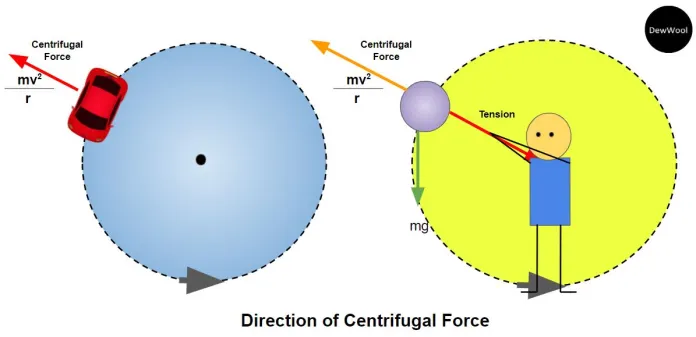Centrifugal force is one of the most commonly discussed forces in physics, particularly when studying motion in circular paths. Whether you’re taking a ride on a roller coaster, driving around a curve, or even simply spinning in place, you’re experiencing the effects of centrifugal force. In this article, we will explore the concept of centrifugal force, its definition, formula, and real-life applications.
What is Centrifugal Force?
Centrifugal force is often described as a “fictitious” or “pseudo” force because it does not arise from any physical interaction but rather from the inertia of an object moving in a circular path. This force appears to push objects away from the center of the circular path, making it seem as though there is an outward force acting on them.
In a rotating frame of reference, centrifugal force is the reaction force that is equal and opposite to the centripetal force, which is the real force pulling the object toward the center of the circle.
Centrifugal Force vs. Centripetal Force
While centrifugal and centripetal forces are related, they are not the same.
Centripetal Force is the real force that acts toward the center of the circular path and keeps an object in motion along that path. This is the force that constantly changes the direction of an object moving in a circle, keeping it from flying off into a straight line.
Centrifugal Force, on the other hand, is the apparent force that pushes an object outward from the center. It is not a true force but an effect of inertia that arises because we are analyzing motion from a rotating frame of reference.
For example, when you’re inside a car turning a corner, you feel pushed toward the outside of the turn. This sensation is due to centrifugal force, which is a result of the car’s turning and your body’s tendency to maintain its straight-line motion.
Formula for Centrifugal Force
The magnitude of centrifugal force can be calculated using the following formula:
Fc=mv2rF_c = \frac{mv^2}{r}
Where:
FcF_c = Centrifugal force
mm = Mass of the object
vv = Speed of the object
rr = Radius of the circular path
Key Characteristics of Centrifugal Force
Dependence on Velocity: Centrifugal force increases with the square of the object’s speed. The faster an object moves along a circular path, the greater the centrifugal force acting on it.
Dependence on Radius: The centrifugal force decreases as the radius of the circular path increases. In other words, the farther you are from the center of the circle, the less the outward force you experience.
No Physical Source: Unlike centripetal force, which has a clear origin (like gravity or tension in a rope), centrifugal force has no physical origin. It’s merely a result of the object’s inertia as it moves in a circular path.
Examples of Centrifugal Force in Everyday Life
Merry-Go-Round: When you’re riding a merry-go-round, you feel as though you’re being pushed outward. This is centrifugal force in action as the ride spins in a circle.
Vehicle Turns: While driving a car, you may feel pushed toward the outside of a curve. The faster you go, the stronger the sensation, even though the car itself is being pulled inward toward the turn.
Washing Machine Spin Cycle: When the washing machine spins to dry clothes, the centrifugal force pushes water out of the fabric. This force is responsible for expelling the excess water, making clothes drier faster.
Earth’s Rotation: Earth’s rotation creates a small centrifugal force at the equator. This force slightly counteracts gravity, which is why objects weigh a tiny bit less at the equator than at the poles.
Centrifuges in Laboratories: Centrifuges use centrifugal force to separate particles in liquids. The faster the liquid spins, the more powerful the centrifugal force, which causes heavier particles to move to the outside of the tube.
Is Centrifugal Force Real?
While centrifugal force is not a “real” force in the sense that it does not come from a physical source, it is a useful concept in physics. It helps explain the effects that are felt in a rotating reference frame. When you are in a rotating system, like a spinning ride or the Earth itself, you experience the effects of centrifugal force, even though it is not directly caused by a physical interaction.
In an inertial (non-rotating) frame of reference, you would not feel this force. However, when you analyze the motion from within the rotating system, centrifugal force can be used to describe the outward feeling of being pushed away from the center.
Conclusion
Centrifugal force plays a vital role in many aspects of daily life, from driving a car to washing clothes. Although it is often misunderstood as a “real” force, it is essential in explaining the dynamics of objects in circular motion. Understanding centrifugal force, its relationship with centripetal force, and its many applications helps us better grasp the mechanics of movement and the forces acting on objects in various situations.


















